July 9, 2010
Air Date: July 9, 2010
FULL SHOW
SEGMENTS
Lake of Significance
View the page for this story
The oil in the Gulf of Mexico has now spread to the shores of all the Gulf States. And, for the first time, tar balls have been confirmed in the southeastern portion of Lake Pontchartrain, an inland lake that abuts the city of New Orleans. Host Jeff Young talks with Robert Thomas, chair of environmental communications at Loyola University, about the significance of this spread — both ecologically and culturally. (06:40)
Whale Sharks in the Gulf
View the page for this story
The world's largest fish has been spotted swimming through crude oil in the Gulf of Mexico. Host Jeff Young speaks with Bob Hueter, Mote Marine Lab’s Director for Shark Research, about the fate of the gentle giant, the whale shark. (05:15)
Listener Letters
View the page for this story
We asked our listeners to suggest words or phrases to describe the BP Gulf disaster and the results are in. How about: Oil vey, we’re in a drill pickle? (01:10)
Senate Seat Showdown
/ Ingrid LobetView the page for this story
California’s three-term Senator Barbara Boxer is one of the state’s strongest environmental lawmakers. Now, she’s facing stiff competition from one of the nation’s top female CEOs. Their differences on environment issues are stark. Living on Earth’s Ingrid Lobet reports. (07:15)
EPA Orders Power Plants to Clean Up
View the page for this story
The EPA has rewritten its rule to force deep cuts in sulfur dioxide and nitric oxide emissions from power plants, a move expected to save tens of thousands of lives and billions of dollars every year. Host Jeff Young talks with University of Maryland Law Professor Bob Percival about the mounting science on smog and soot's health impacts, and why the regulation has been so tough to put in place. (05:30)
Acid Rain is Back
View the page for this story
In the 1970s and ‘80s, sulfur dioxide pollution from industry and transportation were the principle causes of acid rain. The Clean Air Act dramatically reduced those sources. But now, as Dr. William Schlesinger, president of the Cary Institute for Ecosystem Studies, explains to host Jeff Young, acid rain has returned and it’s coming from nitrogen emissions produced by agriculture. (05:20)
Science Note/Aquatic Insects and Solar Panels
/ Meghan MinerView the page for this story
Researchers have observed some aquatic insects laying their eggs on solar panels instead of in water. As Living on Earth’s Meghan Miner reports, this could lead to a decrease in insect populations where solar panels are prevalent. (01:50)
Seeing the Forest for its Bugs
/ Emily GuerinView the page for this story
The hemlock wooly adelgid is eating its way up the East Coast's hemlock forests. Now researchers are fighting back with tiny beetles. Emily Guerin joined an entomologist in York, Maine to see how the forest is faring. (06:15)
A Place Called Home
View the page for this story
The strong sense of place that Kate, Mary Kate and Katie, three generations of women from one family, experience when they go to their lake house in Connecticut inspired each of them to write poetry. When they heard about the EPA’s Rachel Carson Sense of Wonder contest, the women combined their poems into one. Host Jeff Young talks with the women about their winning poem, A Place of Peace. (08:30)
Show Credits and Funders
Show Transcript
HOST: Jeff Young
GUESTS: Bob Thomas, Bob Hueter, Bob Percival, William Schlesinger, Kate Holden, Mary-Kate Holden, Katie Talmadge
REPORTERS: Ingrid Lobet, Emily Guerin
SCIENCE NOTE: Meghan Miner
[THEME]
YOUNG: From Public Radio International - this is Living on Earth. I’m Jeff Young. The Gulf oil reaches the treasured waters next to New Orleans--Lake Pontchartrain--striking deep into southern Louisiana, and the city’s psyche.
THOMAS: It's starting to etch into our culture. And a feeling of well-being that coastal-living people have. It’s destroying what we consider such a wonderful, wonderful ecosystem.
YOUNG: Also what the oil means for the world’s biggest fish, the whale shark. And, in the Maine woods it’s bug versus bug in the battle to save the stately hemlock…
KANOTI: With these predators we aren’t trying to eradicate the hemlock wooly adelgid, that’s not possible anyway, we’re just trying to bring their population below damaging levels.
YOUNG: Also we hear your ideas for a better way to describe the Gulf oil disaster. Those stories and more this week on Living on Earth. Stick Around!
[THEME]
Lake of Significance
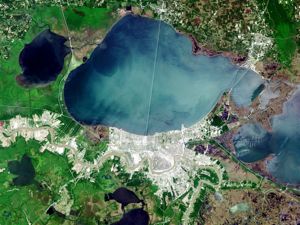
Aerial photo of Lake Pontchartrain and the surrounding region. (Wikipedia creative commons)
YOUNG: From the Jennifer and Ted Stanley studios in Somerville, MA this is Living on Earth. I’m Jeff Young. The Gulf Oil disaster has now reached some historic milestones. By government estimates this is now the biggest accidental oil spill in maritime history.
The recent report of tar balls on the Texas coast means oil has now reached all five US Gulf states.
And in southern Louisiana, the oil passed another important threshold — the entry to Lake Pontchartrain. Professor Bob Thomas chairs environmental communications at Loyola University in New Orleans, a city that worked hard to clean up Lake Pontchartrain. Bob Thomas, welcome to Living On Earth.
THOMAS: Good to be with you.
YOUNG: Now help us out a little with the geography, paint a little mental map for us because this is quite a ways from the open water of the Gulf, isn’t it?
THOMAS: Well, it is. Imagine a large oval that’s 40 miles long and 24 miles across. It’s sitting right on top of New Orleans. To the east there are two openings one is called the Rigolets. The other one’s called the Chef Menteur. And so water comes in from the Gulf, goes through lake Catherine then flows through lake Borgne, comes through either the Rigolets or the Chemantauer and enters Lake Pontchartrain.
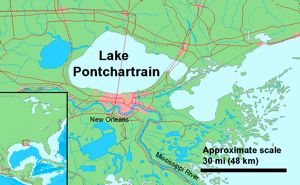
Lake Pontchartrain’s location (Wikipedia creative commons)
YOUNG: How did the oil get all the way up there?
THOMAS: Ah, wind driven probably. We’ve had sustained southeastern winds over the last number of days. It’s not an unusual thing at this time of year, and it just blows seawater back up into the lake. So the oil has just traveled in with everything else.
YOUNG: I guess it must be a real blow to think, gee, if the oil can get into Lake Pontchartrain, where can’t it get?
THOMAS: Well, that’s absolutely true because think of the filters that it’s had to work through to get there. It’s gone though a couple of coastal lakes, narrow entrances into the lake system, and then, we had people out using nets trying to capture as much as they could. The reports are that they actually scooped out 1000 pounds of oil.
YOUNG: What do you think that amount of oil means for the fragile ecology of the lake itself?
THOMAS: Well, I think what’s happening out there right now doesn’t seem to be a major threat at the moment. Most of the oil that’s coming in there is very weathered, so to speak, it’s been in the water a long time, it’s relatively inert. But, that said, what we’re very concerned about is: is this the tip of the iceberg. What quality of oil will come behind it, how much of it will come in, and what impact will that have on this humongous estuary that is a major component of the nursery grounds for the fisheries off coastal Louisiana.
YOUNG: So far though, it sounds like its as much a psychological blow as anything.
THOMAS: Yes it is. And that’s something that people are not talking about enough. This entire oiling along the Northern Gulf coast is a huge psychological weight around people’s necks. People just don’t know what the future holds, but what they do know is that it’s destroying jobs for a lot of people, which just wrecks the economic web down here along the coast. It’s just destroying what we consider such a wonderful, wonderful ecosystem. And because it’s doing those two things it’s starting to etch into our culture and a feeling of well being that coastal-living people have. So people are really, really bothered by this. Well beyond the direct impacts.
YOUNG: Give us a sense of the importance of Lake Pontchartrain to New Orleans’ citizens.

Aerial photo of Lake Pontchartrain and the surrounding region. (Wikipedia creative commons)
THOMAS: Well, first of all, New Orleans is located where it is today because of Lake Pontchartrain. Going back to the 16 and early 1700s, they were looking for a shortcut to the river. And so what they did is they came across the coast, entered Lake Pontchartrain, and found a little bayou called Bayou Saint John now, they went up and they portaged one mile to the river. And, so when they made that discovery they say well look here, this place on the river, this is where we’re going to build a city. And they named it New Orleans.
It’s a place that historically was the recreation place for New Orleans. If you go back through the years, everybody has a story of a family going out to Pontchartrain beach, which was an amusement center, or going to the restaurants at West End. And so it’s sort of entrenched in the lore of New Orleans. And then, on top of that, it is an estuary that serves as the nursery grounds for a large percentage of the commercially important species that we feed on down here. And it’s just a beautiful place.
YOUNG: You know here we are just a little more than a month away from the 5th anniversary of Katrina. How does that anniversary, and the on-going oil incident, come together to affect people there?
THOMAS: Well, it’s like what you’d call a double-whammy. I mean, we’ve dealt with Katrina, and people are just getting their lives back together. And then just as you’re standing up, just as you’re starting to right yourself, and you’re getting off the ground, you get hit again square in the face. It hurts a lot more the second time. The second time is taking away your future. It’s absolutely taking away your livelihood and nobody knows where this is going to end.
YOUNG: Bob Thomas at Loyola University in New Orleans, thanks so much.
THOMAS: Good being with you.
Related links:
- Lake Pontchartrain Basin Foundation
- Robert Thomas’ website
Whale Sharks in the Gulf

Scientists still aren’t sure why whale sharks have their distinctive spots. (Photo: Jon Hanson)
YOUNG: Last summer, scientists who study the world’s largest fish were excited to discover a group of a hundred whale sharks feeding in the waters just off the Mississippi delta. This summer, those scientists hope the whale sharks stay well away. Bob Hueter directs the Center for Shark Research at Mote Marine Laboratory in Sarasota, Florida, and tracks the animals as they travel through the Gulf of Mexico.
HUETER: We’re deeply concerned about whale sharks in that area because these are filter-feeding sharks. They come to the surface, especially in the morning hours, and open their enormous 6-foot wide mouths, and just strain the plankton that’s present in the water column near the surface. They’ll do this for hours and hours on end. In that sense they’re not like the other sharks. They’re more like giant cows. And unfortunately we use “sea cow” for manatee, I really think we should’ve used it for the whale shark, but that’s history now.
But as filter feeders at the surface, you don’t have to be a shark biologist to see how having oil floating on the surface would be a huge problem. And these sharks have a straining device, have a filter pad, in their throats, that traps food, passes food back to the back of the throat where it’s swallowed and then pass water through so they can breathe. So as oil comes into the mouth, it can get trapped on this filter, which kind of resembles the filter in your air conditioner at home, and clog that filter up. Not only then would they not be able to feed, but it’s very possible that they would have troubles breathing.
YOUNG: You recently had a report of a group of what, 10 or so just off your coast there around Sarasota?
HUETER: That’s correct. So we’ve been looking at the distribution of whale sharks in the area and we’ve been noticing that more and more are showing up on the eastern side right here off the Florida Gulf coast, which is highly unusual. We’ve had whale sharks here continuously for six weeks now following about a month after the blow out of the Deepwater Horizon well.
YOUNG: So, maybe they’re sensing the oil and fleeing it?
HUETER: Well, we certainly hope so because oil and whale sharks don’t mix.
YOUNG: You know, we don’t have the benefit of pictures here on radio unfortunately, but describe for us, what does a whale shark look like when you come up on one in the water?
HUETER: Well, whale sharks are the largest fish that have ever existed. They can get to be as long as 45 feet; their background color is like a deep brown or even almost a black, with light-colored polka dots all over them. Although people have known about whale sharks for centuries, they’re greatly mysterious to us.
We don’t know where they give birth to their young, we don’t know where they mate, we don’t know a lot of aspects of their life history, and whale sharks are just absolutely benign creatures. They don’t have a bad bone in their bodies. And they just want to feed. They’re very tolerant of people being around them. It’s almost a religious experience to swim with the whale sharks, to be with an animal that large that’s so powerful and yet so gentle.
YOUNG: And, as part of your tagging program I notice you named one of them Sara, obviously after Sarasota, and she might be ready to give birth, is that right?

Scientists still aren’t sure why whale sharks have their distinctive spots. (Photo: Jon Hanson)
HUETER: She’s just coming into the size of being reproductively mature, and she looked like she was a little pudgy, so we were very excited to get a tag on her to be able to track her. For a select number, about 35 animals, we have used a satellite tag, which transmits to us essentially every day. The information comes down to us by email right to the laboratory. That’s the information, that’s the kind of tag that we have on Sara.
YOUNG: That’s so cool- you basically get an email from Sara.
HUETER: That’s right, Sara phones home just about every day. Just like a good college student.
YOUNG: And, what are you learning about her activity so far?
HUETER: Well she has been off the Florida Gulf Coast for the last month or so and she went south first, then did sort of a U-Turn, and has actually moved up in the north, up in the what we call the “big bend area” of Florida. Staying about 40-50 miles offshore at this point. Now that brings her into closer proximity with the distribution of oil, so we’re very concerned and we’re watching her movements to see if she turns back when she encounters the oil.
YOUNG: What’s your hunch about how this is going to play out for whale sharks in the Gulf?
HUETER: I’ll tell you that once this thing started, I felt such a sense of doom that I was really depressed about it, but as time has gone on, as I reach back and go to that optimistic place that knows that nature can rebound, I am hopeful that the whale sharks will sustain themselves through this disaster in the Gulf and will find a way to stay away from the oil and do other things until the oil is dispersed and they can get back to their normal routines.
YOUNG: Dr. Bob Hueter at the Mote Marine Lab in Sarasota Florida, thank you very much.
HUETER: Thank you.
YOUNG: You can track Sara and other whale sharks in the Gulf at our website,
LOE dot org.
Related links:
- MOTE marine lab’s shark research center
- Gulf Coast Research Lab’s whale shark program
Listener Letters
YOUNG: Last week we talked about the inadequate terms we have to describe the oil mess in the Gulf – spill just isn’t quite right. We asked you for something better, and you came through …
FILEMEO: My phrase that best describes the BP Gulf disaster is “crudal wave,” or “crunami.”
SUTTER: This situation is so much worse than a spill it’s a horrific oil spew.
MEADER: It’s a volcano eruption, an oil eruption. It’s not a spill, that’s for sure.
KOMISAR: It’s not a spill it’s a deluge.
KIRATZIS: The one word that I think describes the oil spill situation is slippery.
MINKOFF: The Gulf of Mexico is suffering an oil bleed.
ROTAS: Mother earth is hemorrhaging. Hemorrhage, hemorrhaging.
BLACKMAN: Hemorrhaging into the Gulf.
STEVE: A human induced tear in the biological fabric.
KOMISAR: Call this the gulf oil tragedy.
YOUNG: Thanks to Len Filemeo, Linda Sutter, Abbott Meader, Donnee Komisar, Stephanie Kiratzis , Seth Minkoff, Gena Rotas, and Bea Blackman. Contributions on our Facebook page, PRI’s Living on Earth, include these gems from Michael Weinberg: Drill Pickle and Oil Vey. And Lorraine in Jacksonville emailed us at comments at loe dot org with my personal pick: "pernicious petroleum propulsion of pandemic proportions."
[MUSIC] The Meters “It Ain’t No Use” from Rejuvenation (Atlantic Records 1974).
YOUNG: Just ahead - climate change and the California contest for the US Senate. Keep listening to Living on Earth!
[MUSIC] Wayne Shorter/Milton Nascimento “Ana Maria” from Native Dancer (Sony Music 1975).
Senate Seat Showdown
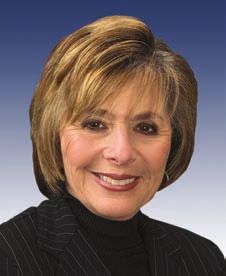
Senator Barbara Boxer of California (D- California) (Photo: Barbara Boxer)
YOUNG: It’s Living on Earth, I’m Jeff Young. This November, one of the Senate’s most prominent environmentalists – California Democrat Barbara Boxer -- faces a strong challenge in mid-term elections. Republican Carly Fiorina was once one of the country’s most powerful female CEOs. Now she wants Senator Boxer’s job. Living On Earth’s Ingrid Lobet has this look at what a Fiorina upset might mean.
LOBET: The way Cary Fiorina’s ads tell it, her rise to the upper echelons of American business was not preordained.
AD VOICE: Her name was Carly. She was receptionist at DJ’s hair design.
That’s how she worked her way through Sanford and got a degree in medieval history. Then came UCLA law school, where she quit after one semester.
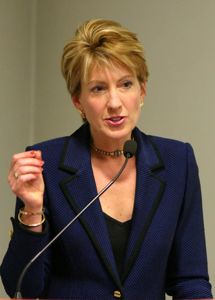
Carly Fiorina is challenging Barbara Boxer for her job as a California Senator. (Photo: Carly Fiorina)
LOBET: Her father once doubted she’d amount to much, she says. But in her 20’s an employer encouraged her to pursue business and she got an MBA. She hit her stride, rose through the ranks at ATT for 18 years, then took the top job at the Silicon Valley institution, Hewlett Packard.
[SFX]: Outdoor ambient sound
LOBET: But there were painful choices to make at HP. At a rooftop campaign event in Beverly Hills, Fiorina defended her decision as CEO to acquire Compaq Computers, and lay off 28 thousand people.
FIORINA: The merger saved the company. Had we not acquired Compaq many more jobs would have been lost. Our PC business wasn’t competitive—and so we would have lost far more jobs.
LOBET: Fiorina is blamed for destroying HP’s employee-friendly culture, and billions of dollars in shareholder wealth. The board fired her in 2005. But some say she deserves partial credit for HP’s subsequent success, and for bringing the company into the digital age. What’s relevant for voters now is that business is Fiorina’s lens on the world. She says it’s her strength.
FIORINA: I think it would help tremendously, to have a person from the largest economy in the nation, an economy that is in deep distress, that knows where jobs come from, that knows how to bring them back, and importantly, knows what it means to manage billions of dollars worth of and cut billions of dollars in expenses.
LOBET: Fiorina speaks in detail and without notes about specific taxes that should be cut so businesses can hire. Curtailing environmental regulations, especially the Endangered Species Act, is also a priority for her. She sees it as a job killer.
FIORINA: 46,000 people lost their jobs because Barbara Boxer believed that a fish was more important than those 46,000 people and their families.
LOBET: It was not Barbara Boxer, but a federal judge in California’s rich San Joaquin Valley, who slashed irrigation water for farmers as he balanced their needs against the health of an inland ecosystem. And most studies find far fewer jobs were lost. But the issue of jobs is key here. Average unemployment in the state is over 12% and there are counties with 16, 20 even 27% unemployment. Tim Hodson directs the Center for California Studies at Cal State Sacramento.
HODSON: Conventional wisdom is that any time the economy is a concern—that people are worried about their personal incomes—that that is a benefit to the challenger. So the Republican candidate, Carly Fiorina, would have an advantage. On the other hand the economy in California is improving, albeit slowly, but it is improving, and California remains a blue state.
LOBET: Often, it’s a state where environmental issues also rank high, regardless of party. Fiorina’s campaign so far indicates that on the environment, she’s a different brand of Republican than Californians have recently elected to high office, for example Arnold Schwarzenegger. In a TV interview, Fox news host Glenn Beck pressed her to promise she’d remain different.
[SFX]CLIP FROM FOX NEWS:
GLENN BECK: Well, you tell me that you’re not gonna be in bed with. Cause, here you are from California…you’re not going to be in bed with the Sierra Club? And the save the whales people…
FIORINA: No, Barbara Boxer is, who’s the opponent. No, I certainly will not.
LOBET: Carly Fiorina’s ads indicate she does not consider climate change a serious matter. The first voice here is Senator Boxer’s.
[SFX] FIORINA AD:
VOICE of BOXER: One of the national security threats we face, frankly, is climate change.
VOICE OF FIORINA: Terrorism kills, and Barbara Boxer is worried about the weather.
LOBET: Fiorina’s campaign has put out some edgy, or downright strange internet ads. In one that again takes on Boxer for her climate change efforts, the Senator’s head is portrayed as a somewhat sinister blimp floating across the country.
[SFX]FIORINA CAMPAIGN AD CLIP:
VOICE: Proclaiming her cap and trade bill would clean the environment, indifferent that it would take already-painful jobless numbers--and make them dramatically worse….
LOBET: The contrast between Barbara Boxer and Carly Fiorina on climate change is stark. Boxer has authored and pushed hard to pass climate change legislation, which she sees as a job engine.
BOXER: There’s going to be a whole new platform for economic growth in this country. America will be the leader. There will be millions of jobs created, thousands of new industries. We know that in California there are 10 thousand news businesses that were formed since California put global warming legislation into place.
POPE: Senator Boxer has been the real leader in the Senate on climate change and losing her would be a huge blow.

Senator Barbara Boxer of California (D- California) (Photo: Barbara Boxer)
LOBET: That’s Carl Pope of the Sierra Club. Boxer, he says, has strongly defended environmental causes during her 18 years in the Senate.
POPE: Senator Boxer was there when we had to stop Ronald Regan from drilling the California Coast. Senator Boxer was there when James Watt tried to sell off our national parks. Senator Boxer was there when Newt Gingrich tried to repeal basic public heath laws that kept meat safe, Senator Boxer has been there when we wanted to protect California’s forests. She’s been there consistently.
LOBET: And because Barbara Boxer is chair of the Senate Environment Committee, if she were to lose to Carly Fiorina, Tim Hodson at Sacramento State says it would have ramifications beyond this one race.
HODSON: The contest between Barbara Boxer and Carly Fiorina does have national implications.
LOBET: If Democrats retain control in the Senate in the November election, Max Baucus of Montana would probably take over the Environment committee. He was the only democrat to vote against a climate bill in committee last fall. And if Democrats lose the majority, the chair would return to Senator James Inhofe of Oklahoma, who views climate change as a hoax, and who says he recently met with Carly Fiorina, and on that issue they see eye to eye.
For Living On Earth, I’m Ingrid Lobet.
[MUSIC] Space Funghi Projetc: Mary Jane On My Mind from The Elektril Psilocybe Experience (Three Sixty Records 2009).
Related links:
- Barbara Boxer’s Home Page
- Carly Fiorina’s Home Page
EPA Orders Power Plants to Clean Up

Smog in New York City. The average coal-fired power plant spews as much ozone-forming nitrogen oxide as a million late-model cars, according to the Union of Concerned Scientists. (Photo: Anke L)
YOUNG: The East Coast heat wave brought more than high temperatures, it also brought warnings like this:
[SOUND CLIP] LOCAL WEATHERCASTER: The heat is on, and for most of Monday, so too was an air quality alert for most of western New York…
YOUNG: Parts of a dozen eastern states were under orange or—in a few cases red—air alerts. A big part of the problem comes from other states to the West.
[SFX] POWER PLANT SOUND up briefly then under]
YOUNG: Old coal-fired power plants, like this Dominion facility in West Virginia, send pollution downwind, with devastating health effects. Now the U.S. EPA has proposed regulations to deal with this interstate transport of pollutants—a problem that’s long vexed environmental regulators. Bob Percival has followed the subject for decades. He directs the environmental law program at the University of Maryland.
PERCIVAL: Well, this rule is going to have enormous health benefits. EPA estimates that it will save between 14,000 and 16,000 lives every year. It will also prevent 23,000 heart attacks, 21,000 cases of acute bronchitis, and almost a quarter-million aggravated asthma cases every year.

Maryland University law professor Bob Percival.
YOUNG: When you look at those health benefits and you realize that the science on this is really sound, it makes you wonder, why has it been so difficult to make the changes to achieve these kinds of health benefits? Cause this has been a long, hard road to get here.
PERCIVAL: Well, it really required a lot of political will to finally invoke the provisions of the original Clean Air Act that were designed to prevent interstate pollution like this. When environmental groups tried to go to court to force action, the courts focused on how uncertain the fate and transport of pollutants were, particularly under the old air quality models we had that made it very difficult to trace what pollution causes what damage in other states. This rule, when it was first issued in 2005, it was challenged in court. And in 2008 the courts sent it back to EPA and said you need to redo the rule.
Now, we have much better data, much better evidence of the health effects, and now EPA expects that it will go into effect in 2012. So it’s a very, very long process before rules like this are adopted.
YOUNG: Do you think that the new rule, as EPA has re-written it here, will pass muster in the courts?
PERCIVAL: Yes, I think it will and I think there are two clear indications of that. One was that, even though the courts stuck down the rule in its July 2008 decision, it agreed subsequently to let the rule stay into effect in order to give EPA time to tinker with the rule and re-write it in a way that would satisfy the demands of the existing law. And secondly, the agency very clearly targeted this rule to the objections the court has made, so I think this rule stands a much, much better chance of being upheld in the courts.
YOUNG: So how do you think those regulated utility companies are going to respond to this? Might they do away with some coal plants here?
PERCIVAL: Well, they’ll probably shut down the plants that have outlived their useful lives. Some may shift to cleaner burning fuels; others will install scrubbers, and other modern pollution control devices. It will result in a 71% decrease in emissions of sulphur dioxide by the year 2014 and a 52% reduction in emissions of nitrogen oxides. And there will be a reduction in emissions of greenhouse gasses as well, which will be a nice side benefit of this regulation.

A coal-fired power plant. (Photo: haglundc)
YOUNG: So, downwind this is going to mean significant health benefits. What is it going to mean upwind? What does this mean for the states that produce this pollution?
PERCIVAL: The amount of costs involved, they estimate it to be about 2.8 billion dollars, are completely dwarfed by the enormous health benefits they estimate as being worth between 120 and 290 billion dollars every year.
YOUNG: However, somebody has to pay that almost three billion dollars cost. Does that cost go onto the ratepayers in those upwind states?
PERCIVAL: That probably will be the case. It’s something that these utilities should have been planning for all along.
YOUNG: And, a lot of this comes back to that aging fleet of coal-fired power plants that, a lot of people think, should have been sent out to pasture many years ago.
PERCIVAL: Yes we made a basic mistake when the Clean Air Act was passed in 1970. We assumed that we could grandfather in the existing plants because their useful life was not that long and that they would soon be returned and replaced by plants that had to comply with much tighter standards.
Unfortunately what happened was that created an economic incentive to keep the old grandfathered plants in operation as long as possible. So they’ve been operating for decades longer than anyone anticipated. That’s why we’re always tinkering with the act and having the agency adopt new regulatory standards, because the basic premise of the act—that EPA should guarantee that we have healthy air quality throughout the nation—remains intact and that’s something that the agency is trying to pursue here with these new regulations.
YOUNG: Environmental law professor Bob Percival at the University of Maryland, thanks very much.
PERCIVAL: Thank you.
Related links:
- EPA on transport of air pollution
- The history of EPA’s CAIR rule
- Prof. Robert Percival’s site on environmental law
Acid Rain is Back

Time and acid rain weathered the face off this statue at the Acropolis. (Photo: Twin Peaks)
YOUNG: One problem we thought the Clean Air act had solved was acid rain. Reductions in sulfur dioxide emissions greatly reduced the problem. But, acid rain is coming back, and this time, coming from a different source. Cary Institute for Ecosystem Studies President William Schlesinger is studying the acid rain rebound.
SCHLESINGER: Most of the acid rain, as it was first identified, was coming from sulphur dioxide from power plants. We see an increasing fraction now coming from nitrogen oxides, what are sometimes called NOX, that come from a variety of sources. Some is from power plants, some is from automobile emissions, and the part that I’ve been particularly interested in is the amount coming from soils, particularly fertilized agricultural soils.
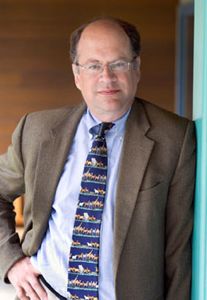
William Schlesinger is President of the Cary Institute for Ecosystem Studies. (Cary Institute for Ecosystem Studies)
YOUNG: From farms?
SCHLESINGER: From farms. Most nitrogen fertilizer that is applied to the soil is added in ammonia, and soil bacteria convert that to nitrate, which is an oxidized form of nitrogen. And in the process of going from ammonia to nitrate, about one-three percent of the nitrogen moving in that pathway is converted to NOX as a metabolic by-product. That’s a gas, and that gas diffuses out to the atmosphere. And in the atmosphere, when it combines with raindrops, it falls as nitric acid.
YOUNG: And, so what does nitric acid do when it is deposited in the rain say on the slopes of a mountain, or in the forest?
SCHLESINGER: The acid part of nitric acid acts in a very similar way to sulphuric acid of the 60s, 70s and 80s, when acid rain was first identified. It leaches aluminum and other positively-charged ions from the soil. In the case of aluminum, that is a toxic element for many kinds of aquatic wildlife. In the nitrate half of the molecule that is what we call a form of excess nitrogen deposition from the atmosphere.
Some species that can use it efficiently and rapidly, do well and others that cannot, disappear. And of course that leads to the impoverishment of natural ecosystems. But it’s interesting, most people have thought of these air pollutants as something in cities, or right down wind of industry, and we now realize they’re much more widespread. And that’s because the NOX is widespread. And so in areas, even rural areas, you can have excessive ozone levels.
YOUNG: So, when we look at the industrial and transportation emissions, I think we know what do to there. It’s just a matter of finding the will to ratchet down the requirements and improve the scrubbers and what not. But what about the farming side? You can’t put a scrubber on a farm, what do you do there?
SCHLESINGER: So, I think the best thing is going to be to think about studies, research, and there’s a lot of it that already exists, that could inform farmers of the best times and seasons to apply fertilizer, to minimize the losses to the atmosphere, which of course is a cost to them anyhow, and maximizes the amount that gets into the crop, which of course is what they really want to be doing. And, to move to reusing of green waste in the fields, plowing under of residue so that the nitrogen applied in one year would be made available the following year and avoid the first use of new nitrogen in that second year.
YOUNG: It sounds like what we’re talking about here is we’re tilting the balance with the whole nitrogen cycle.

Time and acid rain weathered the face off this statue at the Acropolis. (Photo: Twin Peaks)
SCHLESINGER: Humans have roughly doubled the amount of nitrogen that’s made available on land every year by the production of nitrogen fertilizer. It’s been a cheap and easy way to improve crop growth; some people say the human population wouldn’t have grown to its current level without nitrogen fertilizer.
YOUNG: We’re looking at dramatic increase in global population. Aren’t we just going to do more and more and more of that as we have more and more people?
SCHLESINGER: Certainly if we do things the way we have been doing them and we’re going to have human population perhaps go up to about 9 billion or 10 billion people by mid century, we would be using a lot more nitrogen fertilizer. We’d probably be using time and a half what we would be using right now. What’s more, a lot of the new people being added to the planet and the people already here, are saying that they’d like to have more animal protein in their diet.
And of course animals demand a lot of fodder that’s grown on fields with nitrogen fertilizer. That might even increase the demand for nitrogen fertilizer even more! So we’ve got to hank about trying to grow more or the same kinds of crops with lesser amounts of nitrogen fertilizer, that’s used judiciously and efficiently, and essentially will benefit the farmer because less will get away in a not so useful pathway from some of his fields.
YOUNG: Dr William Schlesinger, president of the Cary Institute for Ecosystem Studies, talking to us about nitrogen and its link to acid rain, thank you very much.
SCHLESINGER: Very glad to be here.
[MUSIC]: Marco Benevento “Run Of The Mill” from Not Me (Royal Potato Family 2009).
YOUNG: Coming up: Three generations of poets celebrate a century-old home-place. That’s just ahead on Living on Earth.
[CUTAWAY MUSIC]: Beatlejazz: Beautiful Boy from Another Bite Of The Apple (Silverlight Records 1998).
Related link:
Cary Institute for Ecosystem Studies
Science Note/Aquatic Insects and Solar Panels
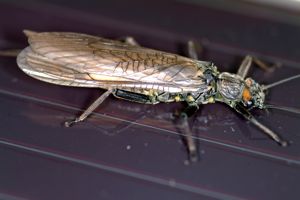
A stonefly rests on a solar panel, confusing it with it's usual resting spot- water. (Photo: Gyorgy Kriska)
YOUNG: It’s Living on Earth, I’m Jeff Young. Just ahead – enlisting a tiny insect to fight a wooly bully –but first - this note on emerging science from Meghan Miner.
[THEME]
MINER: Imagine stepping into a pristine swimming pool. But instead of the cool, refreshing dip you were expecting, your feet rest on a sheet of glass. Researchers have found that some aquatic insects are having a difficult time finding their swimming pools and are landing on solar panels instead!
Scientists at Michigan State University and in Hungary have discovered that mayflies, stoneflies and other aquatic insects become mesmerized by solar panels- buzzing around and even laying their eggs on them.
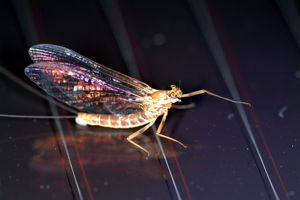
A mayfly rests on a solar panel. Increasingly, mayflies and other aquatic insects are attracted to shiny objects like solar panels because of how they polarize light. (Photo: Gyorgy Kriska)
The bugs use polarized light to find water- but there are some shiny objects that can actually polarize light better than water. Solar panels polarize 100% of the light that hits them, while water can only polarize 60% of light. Solar panels may be enough of a distraction to decrease insect populations in some areas. And, because water insects like mayflies, are part of the aquatic food chain, a reduction in their numbers could spell problems for entire ecosystems in the future.
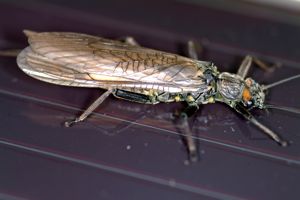
A stonefly rests on a solar panel, confusing it with it's usual resting spot- water. (Photo: Gyorgy Kriska)
But the researchers have found a way to combat this bug bewilderment. They’ve added strips of white tape to break up the solar panel into small squares: the smaller areas look like tiny bodies of water, and become less appealing places for bugs to land and settle down. So, the next time you find yourself lounging by the pool, be thankful you didn’t have to use polarization to find it! That’s this week’s note on Emerging Science. I’m Meghan Miner.
Related link:
Bruce Robertson’s homepage
Seeing the Forest for its Bugs
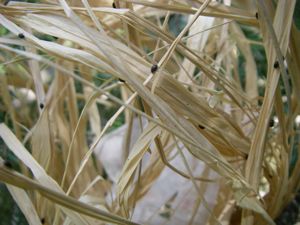
The adelgid-eating predatory beetles crawl on the straw they were shipped with. (Photo: Emily Guerin)
YOUNG: A tiny insect is literally sucking the life out of hemlock trees in the Eastern United States. The hemlock wooly adelgid was first spotted in Virginia in the 1950s. Since then it’s hit roughly half the hemlocks from Georgia to Massachusetts. Some beloved old groves, likes those that shaded streams of Shenandoah National Park, are gone. Now the little adelgid is headed north. Emily Guerin tagged along with an entomologist in York, Maine, to see how scientists in the nation’s most forested state are trying to keep the bug at bay.
[BIRDS SINGING, WIND IN TREES]
GUERIN: Allison Kanoti is pacing up and down the banks of a wooded stream. She stops in front of a hemlock tree, rolls up the sleeves of her oversized Forest Service uniform and runs her hands over the branches, squinting in the bright sun.
[BRANCHES RUSTLING]
KANOTI: It’s important to look on the undersides of the branches, because when hemlock wooly adelgid populations are low, the infestations aren’t going to be very visible from above.
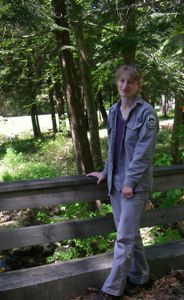
Allison Kanoti stands on a bridge at the York Water district after releasing predatory beetles. (Photo: Emily Guerin)
GUERIN: Kanoti is on the front lines of the battle against the hemlock wooly adelgid. The pest feeds on the tree’s needles, buds and twigs and is an efficient killer—infested trees don’t last much longer than four years.
KANOTI: This hemlock is in really good health, you can see it has a lot of new growth on it and it’s actually still pretty vigorous, and it actually has pretty low adelgid populations. The next tree you’ll see over there actually its in pretty poor health and has a really high adelgid population.
[FOOTSTEPS CRUNCHING ON GRASS]
GUERIN: Kanoti points to a tree she describes as one of the worst looking in the state. Some branches have bare spots and its needles are dry and brittle. She turns the branches over, looking for the insect’s trademark cottony masses. But there are other ways to tell if a tree is infested.
KANOTI: What you’ll notice…is a general lack of new growth…because of that you get pre-mature needle drop so needles will actually fall off and that’s why the crown looks thinner, cause it’s losing those old needles that would normally hold on for 3 years, it’s losing them more quickly…

A nifty bumper sticker on a Maine Forest Service vehicle. (Photo: Emily Guerin)
GUERIN: The wooly adelgid is already threatening a southeastern species with extinction, the Carolina hemlock. But Kanoti and other Maine Forest Service entomologists aren’t standing by while the adelgid eats its way through the state. Instead, they’re using bio-control to keep it in check. Essentially, they’re fighting bugs with bugs.
[TAPE BEING RIPPED OFF A BOX]
GUERIN: Kanoti rips open a box packed with plastic deli containers and crumpled newspaper. Each container is stuffed with dry straw and crawling with five hundred dollars worth of black beetles—at over $2 a piece, they’re pricey little insects. But they feed vigorously on adelgid, their only known prey. Kanoti reaches for a container and peels off the lid, shaking the contents out onto a branch.
[LID BEING PEELED BACK, PAPER RUSTLING]
KANOTI: And they should be ready to feed when we release them. And they’re going to fly around quite a bit, so you may have them land on your and go up your nose and that sort of stuff, so, just a warning…
GUERIN: They’re really small, a lot smaller than I thought, they’re like, almost the size of, you know, a couple of periods on the end of a sentence.
KANOTI: Yeah they’re tiny. They’re just a couple of millimeters maybe, it really makes sense because their prey is also very small.
GUERIN: The Forest Service believes these little beetles are the hemlock’s best hope for combating the wooly adelgid. If the adelgid wins, it’s not only the hemlocks that lose. The trees play an important, irreplaceable role in their ecosystem, especially along streams.
KANOTI: Hemlocks shading the stream actually influence the water temperature, influence survival of some macroinvertibrates living in the stream, and on very small streams, headwater streams, they can extend the seasonality of those streams, so they’re much more important than may be initially apparent, I guess.
GUERIN: Pesticides are more effective against the adelgid but scientists try to avoid using them near streams. And even though the predator beetles are adept adelgid eaters, entomologists know that it’s impossible to eliminate the invasive insect. Allison Kanoti says that’s not their goal.

The bug-covered straw is dumped out on a branch of a hemlock tree. (Photo: Emily Guerin)
KANOTI: With these predators we aren’t trying to eradicate the hemlock wooly adelgid, that’s not really possible anyway, we’re just trying to bring their populations below damaging levels.
GUERIN: While Kanoti and other entomologists work on killing adelgid, lawmakers in Maine are also trying to slow down the insect’s spread. The adelgids move slowly by themselves, but can hitch a ride in firewood. And since Maine is a popular camping destination, the risk is high. So a new law makes it illegal to bring firewood into the state. But Kanoti says, humans inadvertently aid adelgids in other ways. Climate change is a major boost to the insects.
KANOTI: I mean, an example of what a warm winter does, this year we only had about 17% mortality on average across the sites we sampled for over-wintering mortality. I’ve only been doing this for four years but in those four years that is more than half as low as any of the other lower readings I’ve had…and we really want to see over 90% mortality in order to see, sort of, a stable population of adelgid as opposed to an expanding population of adelgid.

The adelgid-eating predatory beetles crawl on the straw they were shipped with. (Photo: Emily Guerin)
GUERIN: The odds are certainly stacked in the adelgid’s favor. Entomologists like Kanoti aren’t even sure how effective bio-control is. It takes multiple releases over many years for the beetles to become established enough to make a dent in the adelgid population. And by then, the adelgid may have moved elsewhere.
But there are some signs of progress. The predator beetles seem to be settling in and are spreading to other infected hemlocks. And Kanoti is releasing more beetles whenever she can get a hold of them, usually about once a year.
KANOTI: Bio-control is a real long-term commitment, really. We’re investing for the long term here. We don’t expect magic results overnight.
GUERIN: Or even within a couple of years. But the hope is that the firewood ban and the beetles will slow the adelgid down, giving foresters time to come up with better ideas to combat the infestation.
For Living on Earth, I’m Emily Guerin in York, Maine.
[MUSIC] Andrei Krylov “Beetles learning Yoga In India” from Dragon From The Dark Side Of The Moon Freakout (Andrei Krylov Music 2010).
Related link:
Click Here for a Map of HWA populations
A Place Called Home
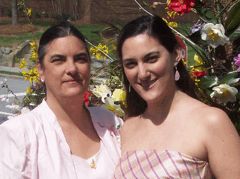
MaryKate and Katie Holden
YOUNG: The root of the word ecology, “eco,” means “house.” And a house that’s truly a home can be a powerful link to our surroundings and the generations of people who passed through. That’s certainly true of the Talmadge family. Their home place in the Connecticut woods is so special to them it’s inspired three generations of poets. Kate, Mary-Kate, and Katie, combined their poems about the home into one and entered it in a contest sponsored by the Environmental Protection Agency: the Rachel Carson Sense of Wonder contest. And, they won! This month they celebrate the 100th anniversary of the house that inspired this winning poem. First of all, congratulations!
ALL: Thank you.
YOUNG: Now who am I talking to? Who’s who here?
KATIE: I’m Katie Holden, and I’m Mary Kate’s daughter, and Kate’s granddaughter.
MARY KATE: This is Mary Kate Holden. And I am in the middle.
KATE: And I’m Kate. The matriarch, the oldest one, at 92.
YOUNG: Now, before we hear the poem, place of peace, I’m wondering where are we in this poem, what’s the setting?
MARY KATE: The setting is at home in Litchfield County, Connecticut, which has been in our family for about 100 years. And it’s a place where all of us have spent summers, and no matter how far away we go from it, we always try to get back there for a short period of time. It’s very natural setting. There’s no radio and there’s no TV and there’s a lot of water, and it means a great deal to all of us in the family.
YOUNG: Well, since you all three wrote the poem, I’d like for you all three to read it for us, if you don’t mind.
MARY KATE: Ok, we can each read the part that we wrote.
YOUNG: OK.
KATE: Knee-deep in purple asters, where maples gaily spill,
Unwept living crimson on our firm New England hill,
Our little half-built house awaits you, serene and still.
Such peace is here
And quiet dreaming.
No din of fear
Like sirens screaming
Or brass bells tolling, no dark hate rolling
That troubles the wind-washed silence under
These white clouds flying.
Only the crying of a far bird calling
Like a feather falling
That flutters earthward from above.
Warm as the sun that softly spills
Its life-giving light across the hills,
Kindling the crimson apples for the day of your returning.
MARY KATE: When sunwashed sky turns crimson gold
And cool breezes fall from top of hill
Bringing clouds of bat food buzzing still
My heart stills quiet and my mind breathes
Lulled after the day's chores done. Memories wash over
Of small children laughing in silver drops of water,
Of teenagers dunking and gliding on skis
Blushing under other's gazes peeking through clover.
My family founded in elder days
Continues the call that Nature makes
For our souls returning to this place of peace,
Where time stands still until we say
Who we are and where we are from.
KATIE: I am from the Lake (wet, warm, natural)
I am from the lily, dogwood, earth, planted in the front yard.
My mother’s earth. I'm from long trips and dark features.
From the long line of Kate's and of Robert.
I'm from the stubborn and matriarchal.
From magic curtains and brownie kisses.
I'm from tall altars and winding passages with spires from the sky.
I'm from Europe- France, England, Germany, Ireland, Scotland,
A mutt all around.
From the broken butt to being my rock and storms.
The stubborn women through and through
I am from the old, dust, moths, mold.
I am from mothers and lakes and lots of people,
With love.
YOUNG: Very nice. I want to go there, I tell you, I want to go there.
KATIE: Everybody does.
MARY KATE: You’re all invited!
YOUNG: It sounds lovely. I want to ask about a few lines that stood out here. “I’m from the stubborn and matriarchal.”
[LAUGHING]
KATIE: That part, we have very strong women in our family…
YOUNG: I gathered that.
KATIE: Yes, and I am very proud to be one of those women and hopefully one day I can be such a big presence that my mom and my grandmother are.
YOUNG: Kate does that hold true for your memories of your mother, your grandmother? Strong women all the way backs?
KATE: Well, yes, but we’re all different people. And my grandmother bought the property in 1910, so our hundredth anniversary is coming up. I wrote my part of this poem in world war two, when my husband was over in the war in Europe for about 4 years right after we were married, and this poem started out initially as a love letter to him to contrast our home with the blood spilling and the bombs dropping and the sirens screaming over in Europe.
MARY KATE: The wonderful thing about her part of the poem is that this place and the memories of this place, it was an anchor for my father when he was in the war.
YOUNG: There is such a strong sense of place being expressed through this poem and through your comments. And you don’t live in this area anymore, but real home is this house, yeah?
KATIE: Yeah, well this is how I explain it. I explain it that my home is in Greensboro, but my heart is in Connecticut.
MARY KATE: Yes we have very long roots; they extend for a long distance.
KATE: And our family has spread out all through the United States. Some of us are out in California, some in Florida, some in Maine, and we all go back there. We would drift apart if it weren’t for our place in Connecticut.
KATIE: And when I went to college, at that time I didn’t really realize how much that place meant to me, and that summer when I was able to go back, it was like I was going home. My heart was at peace, and I really had so much more respect for this place that I had left and started on my own.
MARY KATE: The wonderful thing about this place is that all the generations are there at a time. You have the new born babies in there little place, and the parents of teenagers watching the kids dunking each other, and the matriarchs and the elders looking on from a far and trying to keep up with everyone’s names. It was like that when my mother was small, it was like that when I was small, it was like that when Katie was small, and it continues to be that way.

MaryKate and Katie Holden
YOUNG: Tell me about poetry in your family.
MARY KATE: It’s just a part of us. We’re all very creative people. Poetry is a way of expressing ourselves and it allows us to revisit some of our experiences and some of our feelings.
YOUNG: And Kate, was that something you tried to instill in your daughter and your grand daughter? A love of poetry?
KATE: I always loved poetry and grew up writing it as a little girl. And, I think that Mary Kate and Katie have also done that too. We just like to write.
KATIE: And for me, I have learning disabilities, and for me, poetry is a way to get out what I actually feel about something, and I’ve written so much about the lake it just seems so natural to combine our poems and make it into one big, kind of, story of a life of a place.
YOUNG: Kate, I’m wondering, what’s your earliest memory of that property, or that house?
KATE: Well, it’s a very interesting piece of property. It used to be a hay field filled of beautiful wildflowers. And it has evolved through all my 92 years into a typical, New England hardwood forest. As a little girl I loved every rock and every tree that I could climb and I used to name them. And, all the enchanting, butterflies and little bugs and caterpillars and wildlife has evolved from this beautiful hayfield into a forest with deer, wild turkeys, foxes, coyotes, and the whole landscape has been in evolution like all of us.
YOUNG: Kate Talmage, Mary Kate and Katie Holden, thank you all very much.
ALL: Thank you you’re very welcome.
[MUSIC]: Bill Frisell “Ghost Town/Poem For Eva” from Ghost Town (Nonesuch Records 2000).
Related link:
Click here to read Kate, MaryKate, and Katie’s poem, as well as winners in other categories.
YOUNG: Living on Earth is produced by the World Media Foundation. Our crew includes Bobby Bascomb, Eileen Bolinsky, Bruce Gellerman, Ingrid Lobet, Helen Palmer, Jessica Ilyse Smith, Ike Sriskandarajah, and Mitra Taj, with help from Sarah Calkins, and Sammy Sousa. Our interns are Amanda Martinez, Meghan Miner and Ami Ninh. Jeff Turton is our technical director. Alison Lirish Dean composed our themes. Steve Curwood is our executive producer. You can find us anytime at LOE dot org – and check out our Facebook page – PRI’s living on earth. I’m Jeff Young. Thanks for listening.
ANNOUNCER 1:Funding for Living On Earth comes from the National Science Foundation supporting coverage of emerging science. And Stonyfield farm, organic yogurt and smoothies. Stonyfield pays its farmers not to use artificial growth hormones on their cows. Details at Stonyfield dot com. Support also comes from you, our listeners. The Ford Foundation, The Town Creek Foundation, The Oak Foundation supporting coverage of climate change and marine issues. And Pax World Mutual Funds, integrating environmental, social, and governance factors into investment analysis and decision making. On the web at Pax world dot com. Pax World for tomorrow.
ANNOUNCER 2: PRI- Public Radio International
Living on Earth wants to hear from you!
Living on Earth
62 Calef Highway, Suite 212
Lee, NH 03861
Telephone: 617-287-4121
E-mail: comments@loe.org
Newsletter [Click here]
Donate to Living on Earth!
Living on Earth is an independent media program and relies entirely on contributions from listeners and institutions supporting public service. Please donate now to preserve an independent environmental voice.
NewsletterLiving on Earth offers a weekly delivery of the show's rundown to your mailbox. Sign up for our newsletter today!
 Sailors For The Sea: Be the change you want to sea.
Sailors For The Sea: Be the change you want to sea.
 The Grantham Foundation for the Protection of the Environment: Committed to protecting and improving the health of the global environment.
The Grantham Foundation for the Protection of the Environment: Committed to protecting and improving the health of the global environment.
 Contribute to Living on Earth and receive, as our gift to you, an archival print of one of Mark Seth Lender's extraordinary wildlife photographs. Follow the link to see Mark's current collection of photographs.
Contribute to Living on Earth and receive, as our gift to you, an archival print of one of Mark Seth Lender's extraordinary wildlife photographs. Follow the link to see Mark's current collection of photographs.
 Buy a signed copy of Mark Seth Lender's book Smeagull the Seagull & support Living on Earth
Buy a signed copy of Mark Seth Lender's book Smeagull the Seagull & support Living on Earth

